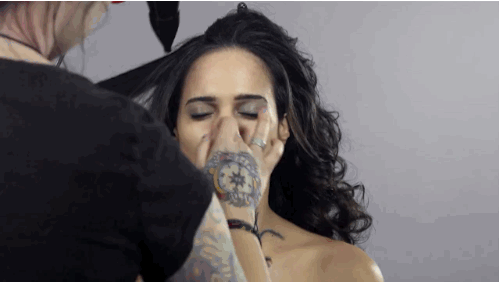For Women in Iran, Exposing Hair is a ‘Stealthy Freedom’ Movement

2010s beauty look from Cut.com’s “100 Years of Beauty” Iran video. (Source: Cut.com)
Since the Iranian Revolution in 1979, women in Iran have been mandated by law to wear loose clothing, known as the hijab, covering the head and neck and concealing the hair. But there is a movement called “My Stealthy Freedom,” currently with over 900,000 Facebook fans, that encourages women to post photographs of themselves in public without the headcover. The campaign was founded by Iranian journalist Masih Alinejad, who is currently based in New York City. (She was once featured in Vogue.) Yesterday, public radio program Here & Now spoke with Alinejad about why she thinks this is an important issue for Iranian women: “Whether you put pressure on us or not, we’re going to stand for our right and we’re going to [defend] our own identity.” She wants women in Iran to be able to choose whether or not to wear the hijab.

1950s beauty look from Cut.com’s “100 Years of Beauty” Iran video. (Source: Cut.com)
In late December 2015, a proposed law that would give more power to Iran’s police and volunteer militias to enforce the wearing of the hijab was ruled unconstitutional by the Guardian Council, a 12-person council that reviews legislation. But while some Iranian women have been finding loopholes around the hijab, such as wearing a thin headscarf and a fashionable long coat with tight leggings, breaking the law can be getting fined or getting imprisoned. The hijab wasn’t always part of daily dress for Iranian women, as noted by Cut.com’s “100 Years of Beauty” video, from 1925 to 1979, when France and Iran had very close relations politically and economically, French beauty influences like pin curls, beehive updos, and ringlets were popular in public.

The photo shown to President Hassan Rouhani of Iran. (Photo: Facebook)
Last week, French journalist David Pujadas gave President Hassan Rouhani of Iran a photo from the campaign, featuring a young woman not wearing a headscarf. According to The Independent, Rouhani responded: “What an issue! We have so many issues so we don’t have time for these things. Everyone in Iran is free in their own private lives to do as they please. But when someone lives in Iran, they should abide by the laws of the country.” He added that the hijab laws in Iran should be dealt with by Iranian lawmakers: “In every country there are rules for the society. There are a number of rules for men and women on dress code and I am responsible to obey the laws,” he told Pujadas. “The laws are made in Parliament and it is the lawmakers in the parliament who approve the laws and all the people must respect the law.” In Pujada’s country of France, the hijab is actually banned from public schools due to a 2004 law which prohibits “ostentatious” religious symbols in public establishments. This ban has been the cause of long-documented controversies in the country.

Example of a photo from the “My Stealthy Freedom” Facebook page. (Photo: Facebook)
Alinejad also wants to dispel the media’s stereotypes about the hijab and about society in Iran — for example, by posting the story of a father encouraging his daughter to take a photo without the hijab. “[A]ll you see through Western media is just, you know, women are being a victim, or all you see through Iranian state TV is just women in black,” she said. “But this is the real face of Iran — this is the hidden face of Iran, and this is the face of Iran which the government of my country want to hide it, want to ignore it, want to deny it.” She adds that there are even women who support wearing the hijab, but do not support the compulsory wearing of it. Columbia University anthropology and women’s studies professor, Lila Abu-Lughod, a heavily cited scholar on the hijab, has noted that many Muslim women voluntarily wear the hijab — that even after Afghanistan was liberated from the Taliban, the majority of Afghani women chose to wear the headscarf. “We must take care not to reduce the diverse situations and attitudes of millions of Muslim women to a single item of clothing,” Abu-Lughod wrote in September 2002. Alinejad, who is exiled from Iran, wants to give the choice of the hijab — or not — back to Iranian women: “[A]ll the government — whether they’re conservative, whether they’re moderate, whether they’re reformists — they don’t want to talk about a simple demand: freedom of choice.”
Related:
Beauty Politics: 100 Years of Persian Beauty in Just Over a Minute

